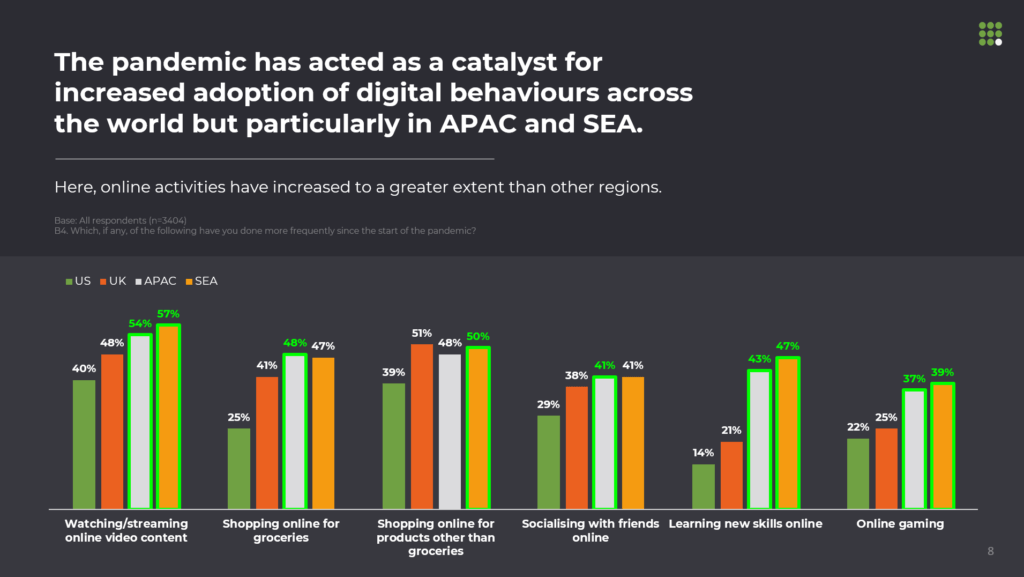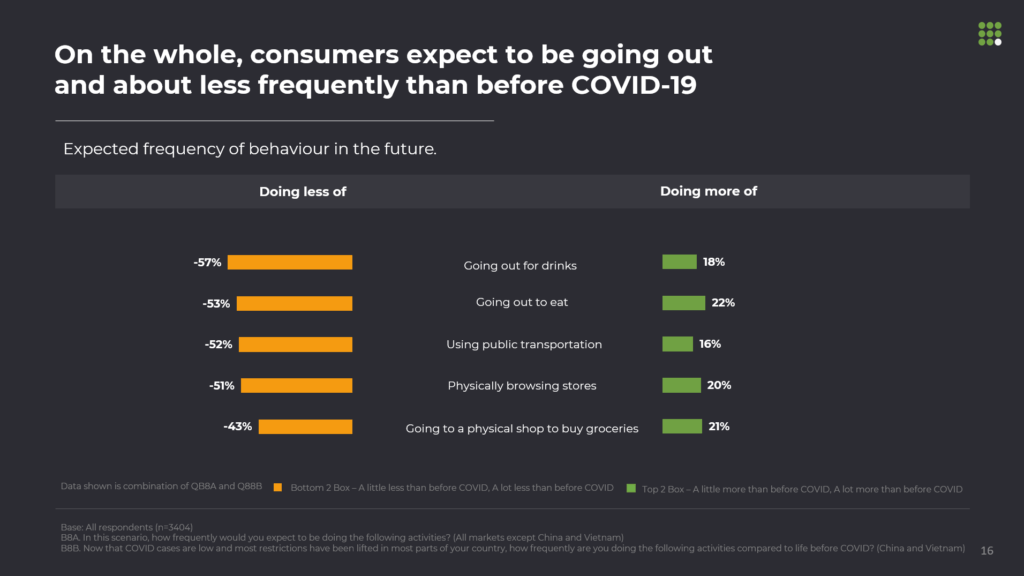A usage and attitude study (U&A) is a brilliant way to understand the market for a given product, brand or category. It gives you a snapshot of how things stand, particularly for brands that people are aware of and use. But it’s also a technique that can help you understand what brands they might consider using – revealing important information about the competitive landscape.
Usage and attitude study objectives
We see that brands looking to embark on a U&A study tend to want to achieve one of the following objectives:
1) To inform what to do next
A usage and attitude study is often commissioned by a marketing team that wants to get some real clarity around the position of their brands in order to build a firm foundation for what they’re going to do next. It’s hard to feel confident about big decisions – such as promotions, product changes, advertising or even brand extensions – when you don’t have an up-to-date view of awareness, usage patterns or perceptions of the brand against competitors. Any of these factors could be pivotal in key marketing decisions.
2) To challenge assumptions
We also often see new management teams or marketing leads coming into a group or a brand management role who are keen to test the temperature around usage and attitudes before weighing up their own strategies. It’s extremely useful for senior decision-makers to have fresh data from a usage and attitude study to challenge long-held assumptions within their team.
3) To create benchmarks
A third use-case is running a usage and attitude study as the first phase of a wider project that might include additional waves of research. Here, we’re creating a clear benchmark for the follow-on work. This is often the case with new product development, for example, or a planned expansion into a new or international market. The U&A study can provide valuable background and context for everything that follows.
4) To understand how changes impact your organisation
One other interesting usage and attitude study objective is to measure the impact of events or major changes – not just after a marketing campaign or change to a product, but in the wake of shifts in the environment. Clearly the Covid-19 pandemic is a perfect example. The dislocation to consumption patterns may have lasting effects for particular brands and products, so a fresh usage and attitude study is a valuable tool for resetting baseline assumptions. But we might also be talking about the entry of a new player into the market, or a shift in infrastructure (such as 5G network roll-out or other innovative tech).
This gives us a useful list of applications:
- Create a snapshot of consumer attitudes to your brand ahead of key decisions.
- Assess the current and potential size of the market.
- Place your brand in a competitive context.
- Challenge assumptions about your brand and products.
- Set a benchmark and context for deeper research.
- Measure the impact on brand or product of major change.
- Test opportunities for brand extension such as new products or markets based on consumer behaviour.
- Spot gaps in the market allied to target consumer attitudes.
- Develop a deeper appreciation for consumer engagement.
There are other applications – but at its heart a U&A study is designed to give you a firm foundation for almost any decision around a brand or a product.
Kicking off a usage and attitude study
For us as a market research agency, the first phase of a U&A project is something we call ‘immersion’. We spend time looking at what the client already knows about their customers and markets, exploring any data they have so we can either benchmark the study we’re going to conduct, or identify gaps in their understanding of usage and awareness ahead of the new study.
Immersion can sometimes highlight areas where previous research conducted by the organisation has missed crucial aspects of brand awareness; or where they can’t explain sales patterns showing strengths or weaknesses in key areas. The more detailed the immersion process, the better: it will help shape and focus the brief for the research to come.
Of course, sometimes a huge data dump isn’t available, or it’s a little out of date. That doesn’t mean a fresh U&A project will be less valuable. Far from it: while it’s true a decent picture of the situation can inform how we run a U&A study, starting fresh can be even more valuable, setting a new, up-to-date baseline for the marketing team and creating a foundation for future research projects and performance evaluation.
The phases of usage and attitude research
Just as a usage and attitude study can often set a baseline for further research or marketing decisions, the starting point for a U&A study is also creating a baseline – asking respondents for the products and brands that come to mind in a given category, entirely unprompted.
Clearly U&A research is designed to explore how consumers feel about, or use, specific brands too. So the next stage is to test their awareness of those brands. That ‘prompted recall’ phase might also include information about what brands in the category the respondents have used – or even have considered using. It creates a more colourful picture of usage and attitude patterns in the category.
At this point, you can dive into more detail: which brands are perceived as ‘premium’? Which brands excel in certain areas, and which perhaps aren’t so highly regarded? The aim in this phase is to get an idea of the relative strength of the competition. And it’s here your own brand’s place in the larger landscape probably comes into focus.
You can also ask in more abstract terms about product categories or even specific SKUs to get a more granular picture – which can be very useful as context for insights centred on your own brand.
So the sequence for exploring usage and attitude is pretty straightforward, and actually maps nicely onto traditional conversion models, such as the classic sales funnel:
- Unprompted recall of brands or products in the category.
- Level of awareness when prompted.
- Level of consideration of the brand or product.
- Levels of agreement with various statements about the brand.
- Usage of the brand or product.
- Repeat usage or promotion of the brand.
In most cases, it’s also useful to build out the same funnel – levels of awareness, consideration, usage and advocacy – for competitor brands too. Understanding how they compare – not least in terms of demographics – with the brands in question can be among the most valuable insights for your marketing team.
And for many clients, usage and attitude research can be an essential tracker study, measuring the change in usage and awareness at regular intervals. This is especially useful when you’re conducted major projects such as new product launches or marketing and advertising efforts. Usage and attitude research is a superb way to measure their effectiveness.
Methodology: “measure twice, cut once”
While the questionnaires for usage and attitude research might seem formulaic, there is a good deal of market research expertise that goes into optimising the value of the resulting insights.
A great example is the importance of sampling. In any survey, the sample should be genuinely representative of the population you’re interested in. You need to avoid skewing the demographics towards a younger, more brand-conscious audience, for example, if you’re going to secure a valid perspective of attitudes across your market.
But for very specific categories, sample selection is even more important. We worked recently on a usage and attitude study for a well-known manufacturer of farm machinery. Taking a general sample here is a little pointless. But even if you’re selecting for a particular group – in this case, farmers – you still need to carefully calibrate the sample. We looked at their primary crop types, the size of farms, regional representation and much more – so that the sample was as representative within that group as possible.
The old carpenter’s adage “measure twice, cut once” is the rule here. Getting the sample right (and using proven methodologies more generally) will secure much more compelling and reliable insights later on.
Online methodologies were already an option for usage and attitude studies prior to Covid-19 lockdowns, and obviously they have been critical during 2020 and 2021 when access to people face-to-face has been limited. They’re very efficient, too, but for usage and attitude studies it’s often sensible to augment with CATI (Computer-Assisted Telephone Interviewing) – not least in situations where a highly targeted and representative sample is needed. That’s particularly true, for example, in business-to-business environments.
Remember that research projects can be modular. We worked with one company that wanted to understand where they sat in the range cooker market – and how they stacked up against their rivals. We built a sample of people who already own that kind of cooker – then weaved a net promoter score (NPS) question set into a wider usage and attitude study. It was a good example of how a U&A study can dovetail with other research methodologies and objectives.
One other methodological point: by definition, some of the U&A questions will ask consumers or business decision-makers to be highly subjective and even emotive. That places additional emphasis on qualifying questions and careful analysis of the results.
Stay ahead
Get regular insights
Keep up to date with the latest insights from our research as well as all our company news in our free monthly newsletter.
![]()
Top tips for usage and attitudes studies
- Know exactly what you want to learn from the research – it could be general background or highly specific, in-depth usage patterns.
- Know what you can change as a result of the research – as well as realistic idea of how the research my shape decision-makers’ thinking. This will help prevent the research becoming unwieldy or over-generalised.
- Unambiguous questions are valuable – people should have the same reference point for the survey. A usage and attitudes study should be conclusive, not a topic for never-ending debate about what people meant.
- Find a neutral starting point – a baseline – for people’s assumptions and ratings. This will help frame a solid interpretation of the results.
- Thinking carefully about the competitor brands you need to understand – it can be risky to ignore smaller brands or niche products.
- Think about results presentation – visualising the results (showing brand strengths in different parts of the conversion funnel, say) or making under- and over-indexing against rival brands very clear.
That might mean the translation of survey questions has to be tweaked to be more practical or accessible to users depending on the format or technology being used in the field. It’s another reminder that having a single, integrated agency working on the project – handling the research design as well as the fieldwork and analysis – will bring many benefits.
Looking for support with usage and attitude research?
At Kadence, we have conducted usage and attitudes surveys for a host of brands. Take a look at our capabilities in this space or get in touch to discuss a project.









 Senior Marketing Executive
Senior Marketing Executive Sales & Marketing
Sales & Marketing Vital Strategies
Vital Strategies
 Customer Intelligence Director
Customer Intelligence Director